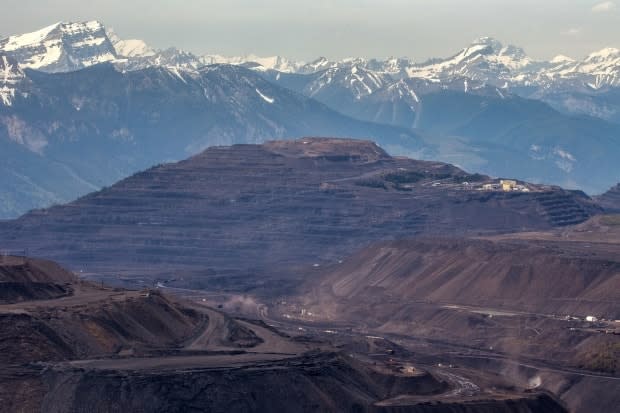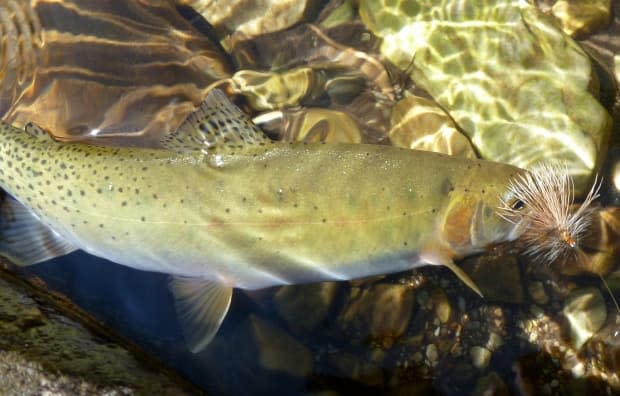Alberta government wants to rewrite the water use rules along eastern slopes of Rockies

The Alberta government wants to rewrite the rules on water use along the eastern slopes of the Rockies as part of its economic recovery plan, including a push for new coal developments in the area.
Water use is highly restricted in southern Alberta due to concerns about supply, and new water licences cannot be issued, they have to be purchased from existing licence holders on the open market.
The new plan put forward by the Alberta government would affect water pulled from the Oldman watershed above the dam.
Current rules for the watershed stipulate only certain amounts of water can be used for designated activities, including irrigation, municipal water supplies, recreation and a limited amount for industrial use.
The new government plan would eliminate those categories and set one overall limit for all uses, allowing industrial extraction to dramatically increase if coal projects are brought online.
Currently, 16 per cent of the water that can be pulled from the area is used or spoken for, but under the new plan that could quickly jump to 30 per cent based on two unspecified coal projects, according to a government presentation given to municipalities on Nov. 20 and acquired by CBC News.
A further 20 per cent would be placed off limits for "fish and the aquatic environment," leaving half of the available water up for grabs.
'Bad trade'
Cam Gardner is both a councillor for the Municipal District of Ranchland and a rancher on the eastern slopes. He isn't impressed with the government's plan.
"It seems to me that the Government of Alberta is hell bent on making a bad trade here: leaving Albertans with a multi-generational liability of cleanup for a few hundred jobs, risking drinking water for about a million people in southern Alberta just for a few million in revenue for a couple of municipalities, one of which doesn't want the revenue," he said.
"They're coming after our water allocation, which is what we need for the future growth of our municipality, in a water basin that's already over allocated in a drought-prone region."
Gardner says the growth industry in his municipality is tourism, and agriculture is a huge driver. He says downstream of the mines there are a million head of cattle as well as a vast agricultural economy.
"I don't think we need the perception that there could be by bio-accumulating heavy metals in our product we're trying to export," he said, referring to the potential of coal mines in the headwaters.
Need for development
Next door to the M.D. of Ranchland is the M.D. of Crowsnest Pass, which supports the development of coal projects in the area as a means to bring in much-needed revenue and jobs.
Mayor Blair Painter says he was pleased with the government presentation and says access to water is a major roadblock to economic development in the area.

He said it's not just about coal mines and that the changes would allow for any number of industrial users.
"Everyone is looking for water," he said.
Currently, 150 acre-feet of water is set aside for industrial use from the watershed, but all of that has been set aside for the proposed Grassy Mountain coal mine near Crowsnest Pass.
For Painter, the one outstanding question was whether the government was basing its assumptions on high water flows or low water flows, and how that might affect the assumptions.
The government points to the fact that 84 per cent of the water that can be pulled from the watershed is not being used as a justification for removing the barriers to access, and it stresses the need to "allow market forces to drive water use, activity and innovation in the area."
Early stages of discussion
In an emailed statement, Jess Sinclair, the press secretary to the minister of environment and parks, said the government is in the early stages of what she called a discussion of potential changes.
"Our proposed changes would better support Alberta's recovery plan by making water resources in an underused area available for all potential uses, while also ensuring a healthy aquatic environment — including considerations for the province's native trout species — by reducing the total amount of water available," she said.
Sinclair said the government remains engaged with the municipalities affected, as well as the Piikani Nation and the Oldman Watershed Council.
Shannon Frank is the executive director of the watershed council, a non-partisan advisory organization partnered with government that works with industry, agriculture and other users on issues related to water use in the area.
She said there are many questions still to be answered, particularly where the water will come from within the watershed and how the allocations will shift over seasons as water levels rise and fall.
"The key is that we don't yet know where exactly the water would be withdrawn, and that's what you need to know in order to decipher any sort of environmental impact," said Frank.
Frank said there is solid data on flows for the larger rivers like the Oldman, but not for those smaller creeks.
"If the Grassy Mountain mine, if they withdraw from Gold Creek, we don't have a lot of information on that one," she said.
Frank said that unlike irrigation for crops, a coal mine requires water year round. She said the government suggested there would have to be water shortage plans for mine operators and they would likely have to provide their own storage for times when they can't pull from the supply.
She said some agricultural stakeholders feel they're losing out in the proposal and are concerned about the precedent if the government comes in and takes away water that isn't currently being used.
Environmental concerns
The proposed water changes come after the government unilaterally and without warning rescinded a coal policy dating back to 1976 that essentially prevented open-pit mines along the eastern slopes of the Rockies.
That change cleared the way for a handful of mines to move forward more aggressively on their plans for operations in the Crowsnest Pass.
Katie Morrison, the executive director of the Canadian Parks and Wilderness Association, says the new proposal on water licences reflects a misunderstanding of the value of the resource.
"I think saying that it's not being used is a little narrow thinking in that it is not necessarily being used for human, commercial or industrial purposes," she said.
"It is water in that system that supports essentially the functioning of that entire system, the functioning of our source water areas, of our fish and wildlife habitat, of our aquatic systems in that region."
Morrison said coal mines are particularly concerning due to the vast quantities they use, but also the fact that it can leach harmful pollutants into the water system, including selenium.
Water pollution is just one of the environmental issues plaguing mines on the other side of the Rockies in B.C., where the industry is thriving.
"I think it's a little bit of a false dichotomy to say we definitely need coal for the economy, because it doesn't take into account all the other economies that are being affected by coal, and also all the other economic impacts of the environmental liabilities created," she said.
A spokesperson for Riversdale Resources, which owns the proposed Grassy Mountain mine, said the project has secured more than enough water for the mine and will "incorporate industry-leading practices to manage water use."
A fact sheet from the company says there will be no tailings ponds and the project will "incorporate modern filters and centrifuges to maximize water reuse and recycle," and is specifically designed to manage selenium.
The water market
Another issue created by the proposed changes is the impact it could have on Alberta's water market, where existing users sell unused allocations from the river basins.
"By closing the South Saskatchewan basin to new allocations, we established a market," said Nigel Bankes, chair of natural resources law at the University of Calgary.
"And we basically said to people, if you want to acquire rights, you're going to have to do that in the marketplace. And what this change will allow is industrial users to say, 'ah, but in the Oldman there's another way of acquiring rights, and that's to lobby government to change the existing allocation order.'"
Bankes says that's not fair to those who have purchased licences and it affects confidence in the established market.
"Political interference with markets, once you've made the decision to establish them, is not a good idea," he said.
Fish protection
Bankes also said no plans have been finalized for the protection of threatened trout species in the area.
"We know that the government is proposing to set aside some of the reservation for environmental flows, but I guess what we don't know is whether that's adequate," said Bankes.
"And how it will jibe with those recovery plans required by the Species at Risk Act."

That question was also raised by Frank, with the watershed council, who said more work needs to be done to collect the needed data.
Sinclair, with environment and parks, said the amount of water required will vary from year to year but argues the new proposal has "given us an opportunity to hold back a larger portion of water in order to better support surrounding species and local sources of drinking water."
'Outhouse next to your spring'
Bankes said another issue that is sure to come up is consultations with the Piikani Nation, downstream of the reservoir.
The Piikani Nation did not responded to an interview request by the time of publication.
Gardner says it didn't seem like the government approached the M.D. of Ranchland as part of a consultative process, but rather presented what they wanted to do.
He said there was no one there to take notes and mark down concerns, and he worries the government is forgetting about the years of consultations that went into the existing regulations.
Gardner said those who work in the hills learned long ago that you don't "put your outhouse next to your spring," and says he hopes Albertans haven't forgotten that lesson.
"I would just ask Albertans whether in a closed water basin in a drought-prone region, this is what they want their water to be used for — is to wash coal to send to China," he said.


